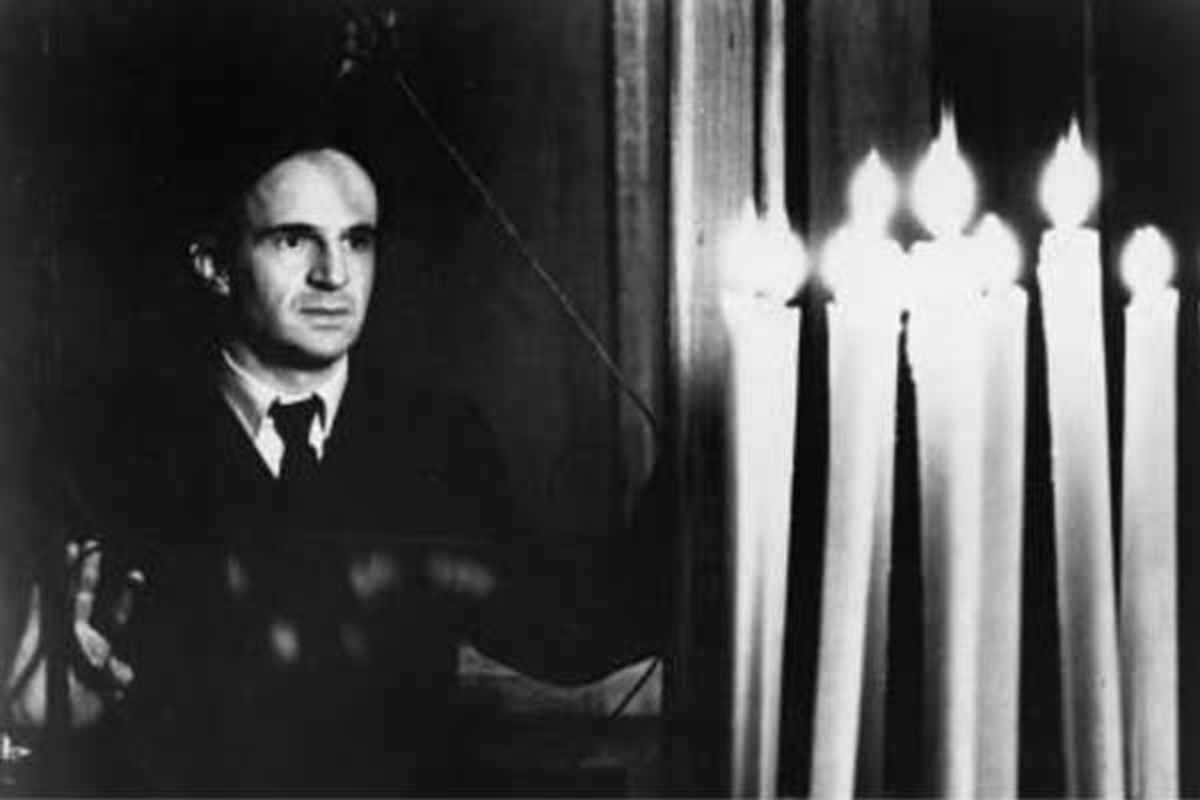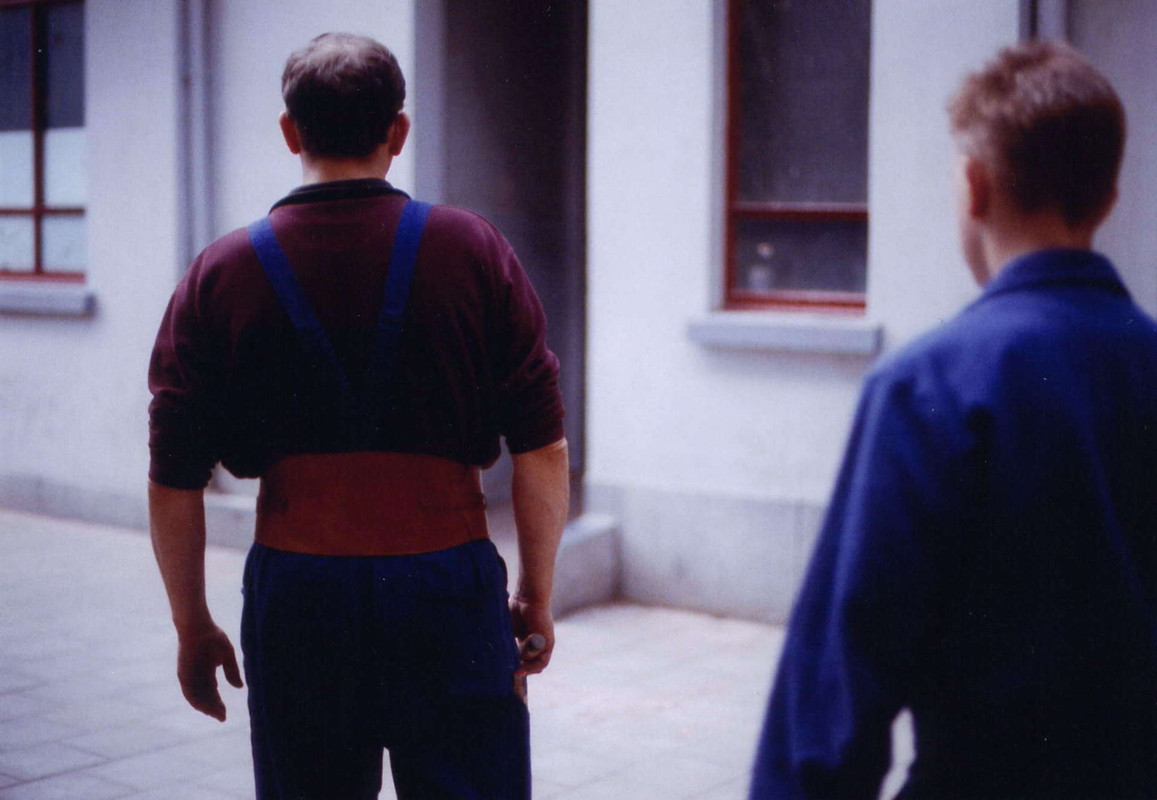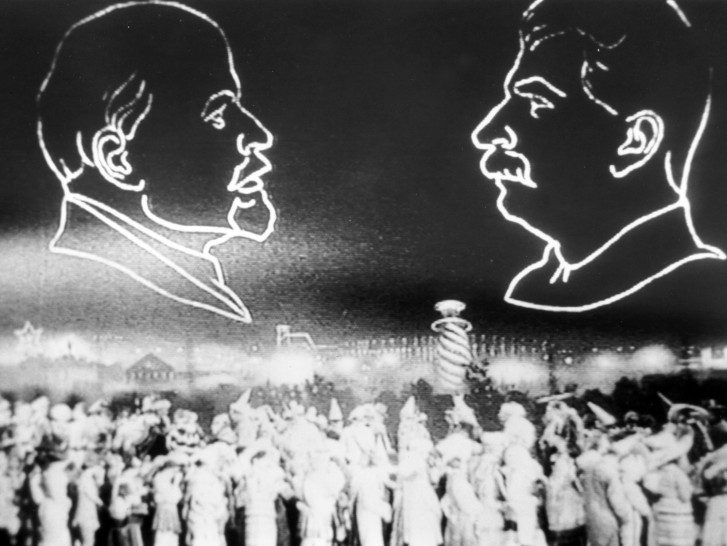“Our past doesn't belong to us.”La Chambre verte [The Green Room / The Vanishing Fiancée] (François Truffaut, 1978)
Mar
17

Julien Davenne (Truffaut). DP: Néstor Almendros.
France
“With these shots from the back and the neck, we hope to confront the spectator with a mystery, the impossibility of knowing and seeing. The face and the eyes should not try to express a situation that already sufficiently stirs up the spectator’s interests. This expression would direct, limit or even prevent expectations, whereas the back and the neck allow the spectator to go deeper, like a car driving into the night.”Le fils [The Son] (Jean-Pierre Dardenne + Luc Dardenne, 2002)
Mar
15
Idus Martiae

Olivier (Olivier Gourmet) and Francis (Morgan Marinne) both seen from the back, with the pupil following the teacher. DP: Alain Marcoen.
For Idus Martiae, the Ides of March, a scene showing the main character's back.
Olivier, a carpentry teacher at a youth rehabilitation center, has a new apprentice, 16 year old Francis. Fascinated by the boy and his unspoken backstory, he starts following him around.
– Luc Dardenne, via [spoilers]
“The Dardennes' brothers’ camera follows Olivier in his enigmatic, ominous obsession with the boy and almost constantly films him up close and from behind. In the absence of a true gaze, the back turns into a face that speaks but doesn’t explain anything, “a body that becomes a vibrating membrane”, as Jean-Pierre Dardenne so beautifully put it.” (via)
“You're a foreigner and you're lost.”L'immortelle (Alain Robbe-Grillet, 1963)
Mar
12
National Hitchcock Day

A woman in silhouette (Françoise Brion) enters a building. The setup is perfectly symmetrical except a beam of light passing through the opened doors that highlight's the woman's presence, adding a sense of wrong to the scene. DP: Maurice Barry.
A favourite non-Hitchcock mystery for National Hitchcock Day (USA)
L'homme à la valise [The Man with the Suitcase] (Chantal Akerman, 1983)
Mar
11
close quarters

Henri (Jeffrey Kime) and the woman (Chantal Akerman) at a claustrophobically small table, each eating their breakfast. The woman has a baguette, a bowl of coffee, and a cigarette. Henri takes up most of the table with a serving tray holding a whole box of Pelletier toast, a plastic milk bottle, and a coffee pot. He's also manspreading. DP: Maurice Perrimond.
Close quarters: US premiere of 10 Cloverfield Lane (2016).
A filmmaker (Akerman) reluctantly hosts a guest (the always imposing Jeffrey Kime) in her already cramped quarters. His increasingly expanding presence in volume, sight and sound are insufferable for the quiet cineast.
Le Songe Des Chevaux Sauvages [Dream of the Wild Horses] (Denys Colomb de Daunant, 1960)
Mar
10
ithrah69's birthday

Camargue horses galloping through a haze of water and dreams. DPs: Denys Colomb de Daunant & André Costey.
A film ithrah69 may like for their birthday.
Filmmaker and photographer Colomb de Daunant's spiritual sequel to Crin blanc : le cheval sauvage [White Mane] (1953) and Glamador (1958) follows the same wild Camargue horses in their dreams.
The accompanying music is performed on a Cristal Baschet, a glass instrument key to several avant-garde films. I refer to John Coulthart's writeup about Le Songe, which links through to an article about the Cristal Baschet.
“She's always happy. She desires nothing, envies no one, is curious about nothing. You can't surprise her. She doesn't notice the humiliations, though they happen to her every day. It all rolls off her back like some waterproof material. Zero ambition. No moral code. Not even a whore's love of money.” Io la conoscevo bene [I Knew Her Well] (Antonio Pietrangeli, 1965)
Mar
5
Crispus Attucks – 1770

Adriana (Stefania Sandrelli) seen through her apartment window. Rome is reflected in her face. DP: Armando Nannuzzi.
A wasteful act: Crispus Attucks, (arguably) the first American victim in the American Revolution, dies on March 5th, 1770.
– The Writer
An ambitious but aimless girl – she wants to be loved, and to be a model, a proto-Edie – mills about her day.
Sublimely shot, we see Adriana through glass panes, in reflections, in an off-focal plane, in other people's words.
“I like the settings where the lights and desire cross path. The desire to communicate with the invisibles in the darkness, or in memory, or in the future. It's always related to cinema and we as insects that are drawn to lights.”สัตว์วิกาล [Sud Vikal / Vampire] (Apichatpong Weerasethakul, 2008)
Mar
2
Dr. Seuss' birthday

Applying blood to attract the Nok Phii. It's cold. DP: Chaisiri Jiwarangsan.
Imaginary animals or food for Theodor “Dr.” Seuss Geisel's birthday (1904).
– Apichatpong Weerasethakul, via
Villagers in the north of Thailand reported a rare sighting of a male and female Nok Phii, an elusive species of bird that feeds on animals' blood. It is unknown if the sighting was reliable, and if this vampire does, or ever did, exist.
Le tombeau d'Alexandre [The Last Bolshevik] (Chris Marker, 1993)
Feb
25
Warsaw Pact

Still from a Medvedkin film. Silhouettes in light of Lenin and Stalin facing each other are projected above a crowd of people. DP of Le tombeau d'Alexandre: Chris Marker.
A film about communism to commemorate the dissolution of the Warsaw Pact on February 25, 1991
– press kit (via)
A film essay using the life and work of filmmaker Aleksandr Medvedkin to tell the story of communism. Medvedkin traveled the Soviet Union with his Kinopoezd or Cinetrain (also Agit-train), a moving film production train with the sole purpose to create Agitprop while documenting the Five Year Plan.
– Why are we making pancakes? – Monsieur likes them. Besides, what else is there?Les abysses [The Depths] (Nikos Papatakis, 1963)
Feb
18
pancakes

Michèle and Marie-Louise (real-life sisters Francine and Colette Bergé) as the real-life Papin sisters prepare crêpes for Monsieur. DP: Jean-Michel Boussaguet.
“My God. What am I doing in this place?” Le charme discret de la bourgeoisie [The Discreet Charm of the Bourgeoisie] (Luis Buñuel, 1972)
Feb
16
No One Eats Alone Day

The diners at a long table. DP: Edmond Richard.
People eat dinner together on No One Eats Alone Day*
– Henri Sénéchal
The bourgeoisie meet for dinner in various settings, but never consume.
* this event takes place on the Friday of the second full week in February, which makes the 2025 date February 14.